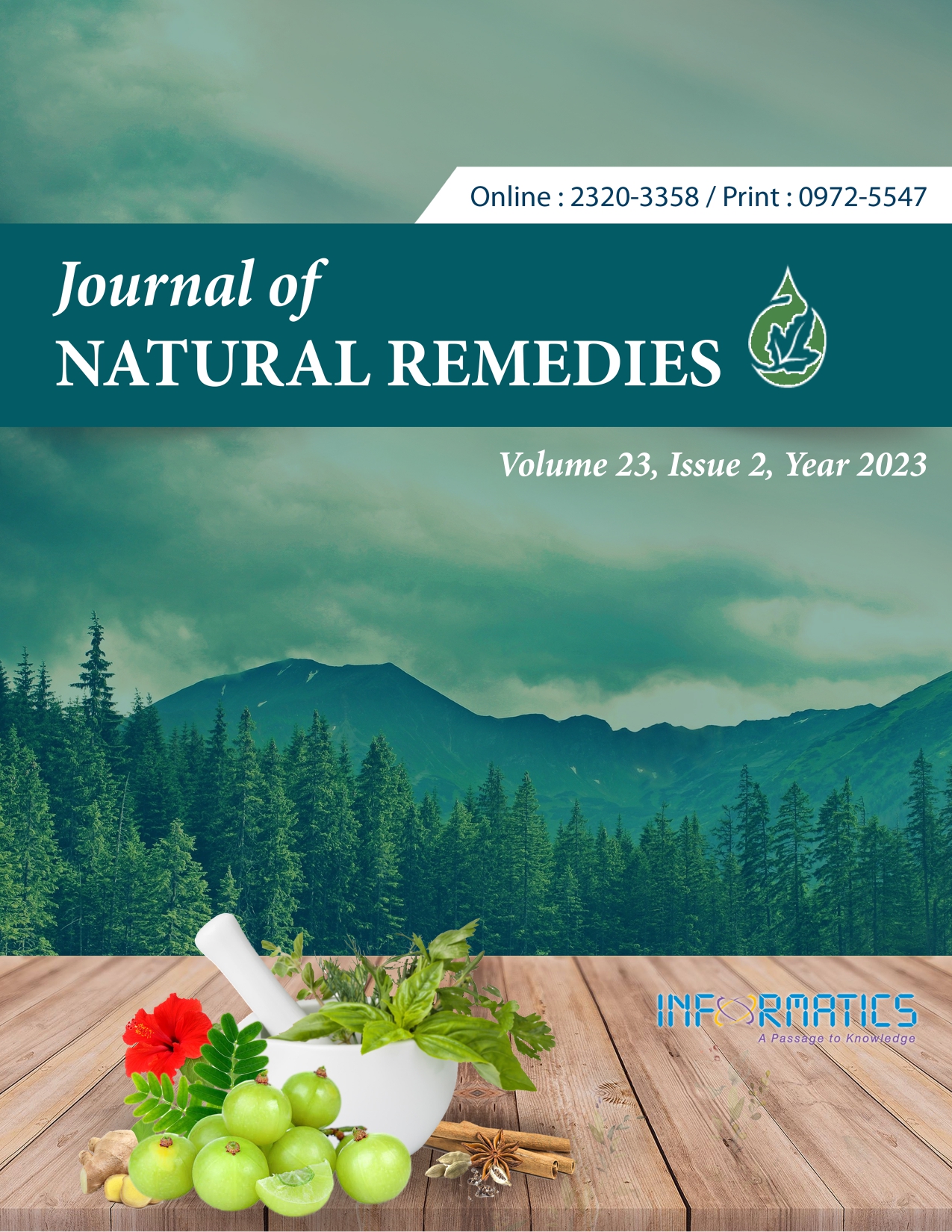A Randomized Standard Controlled Clinical Trial of Unani Topical Formulation in the Management of Dermatomycoses
DOI:
https://doi.org/10.18311/jnr/2023/32287Keywords:
Dermatomycosis, Fungal, Infection, Medicine, Tinea, UnaniAbstract
Dermatomycoses are the human’s oldest recognized and reported infections, which are the fastest growing infections of the skin, hair, and nails. These infections are a global concern due to their ever-increasing prevalence of about 25-27 %, high rate of relapse/recurrence, and resistance. The study was conducted in search of safer and more effective natural medicine. The effect of the standard drug, Terbinafine cream as control is compared with the test drug, Unani formulation in the paste form for local application, containing Kaththa (Acacia catechu), Hena (Lawsonia innermis), Mazu (Quercus infectoria), Kibreet (Sulphur), and Suhaga (Borax). The data on the effect of the control and test drugs on the various features of the dermatomycoses shows that the Unani formulation is almost similar to the standard drug in terms of Mycological cure and Clinical cure statistically. Hence, Unani formulation can be used in the treatment of dermatomycoses.
Downloads
Metrics
Downloads
Published
How to Cite
Issue
Section
License
Copyright (c) 2023 Zamir Ahmad (Author)

This work is licensed under a Creative Commons Attribution 4.0 International License.
Accepted 2023-04-24
Published 2023-06-13
References
Nenoff P, Krüger C, Ginter-Hanselmayer G, Tietz H-J. Mycology–An update. Part 1: Dermatomycoses: Causative agents, epidemiology and pathogenesis. Journal der Deutschen Dermatologischen Gesellschaft. 2014; 12(3):188-210. https://doi.org/10.1111/ddg.12245
Homei A, Worboys M. 1. Introduction. Fungal disease in Britain and the United States 1850-2000: Mycoses and Modernity. Springer; 2013. p. 6. https://doi.org/10.1057/9781137377029_1 DOI: https://doi.org/10.1057/9781137377029_1
Qumri AMHBN. Ghina Muna urdu translation as Minhajiul Ilaj, CCRUM, Ministry of AUYSH. p. 481-2.
Tabri AHAbR. Firdous ul Hikmat (Urdu Translation) by Hakim Rasheed Ashraf Nadvi. CCRUM. p. 640.
Tib AMIZa-R. Alhavi fit, Urdu translation by S A Jafr and M Y Siddiqui, Volume 23rd part. Saba Publication. p. 46-52.
al-Tabari A-HAIMa-T. Kitab al-Mu’alajat al-Buqratiyyah. CCRUM. Vol 3: 211-13.
Majusi AbA. Kamil us Sana (urdu translation) by Hakim Ghulam Husnain Kanturi, Jild 2nd part. CCRUM. p. 439.
Sina AAa-HIAI. Al Qanoon. Matba Nawal Kishore, Lucknow. 1929; 4:359-61
Wellcome AH, Worboys M. Fungal disease in Britain and the United States 1850–2000 mycoses and modernity. Palgrave Macmillan, Macmillan Publishers Limited, Hampshire, U.K; 2013. p. 19-45. https://doi.org/10.26530/OAPEN_474551 DOI: https://doi.org/10.26530/OAPEN_474551
Narasimhalu CR, Kalyani M, Somendar S. A cross-sectional, clinicomycological research study of prevalence, aetiology, speciation and sensitivity of superficial fungal infection in Indian patients. Clin Exp Dermatol. 2016; 7(324):2.
Verma S, Verma G, Sharma V, Bhagra S, Negi A, Tegta GR. Current spectrum of dermatophytosis in a tertiary care hospital of North India–A 6-year clinicomycological study. J Med Sci Clin Res. 2017; 5(3):19488-94. https://doi.org/10.18535/jmscr/v5i3.184 DOI: https://doi.org/10.18535/jmscr/v5i3.184
Sharma R, Adhikari L, Sharma RL. Recurrent dermato-phytosis: A rising problem in Sikkim, a Himalayan state of India. Indian J Pathol Microbiol. 2017; 60(4):541. https://doi.org/10.4103/IJPM.IJPM_831_16 DOI: https://doi.org/10.4103/IJPM.IJPM_831_16
Nenoff P, Krüger C, Ginter-Hanselmayer G, Tietz H-J. Mycology – An update. Part 1: Dermatomycoses: Causative agents, epidemiology and pathogenesis. Journal der Deutschen Dermatologischen Gesellschaft. 2014; 12:188-210. https://doi.org/10.1111/ddg.12245 DOI: https://doi.org/10.1111/ddg.12245
Seebacher C, Bouchara JP, Mignon B. Updates on the epidemiology of dermatophyte infections. Mycopathologia. 2008; 166:335-52. https://doi.org/10.1007/s11046-008-9100-9 DOI: https://doi.org/10.1007/s11046-008-9100-9
Bassiri‐Jahromi S. Epidemiological trends in zoophilic and geophilic fungi in Iran. Clin Exp Dermatol. 2013; 38(1):13-9. https://doi.org/10.1111/j.1365-2230.2012.04462.x DOI: https://doi.org/10.1111/j.1365-2230.2012.04462.x
Kainthola A, Gaur P, Dobhal A, Sundriyal S. Prevalence of dermatophytoses in rural population of Garhwal Himalayan Region, Uttarakhand, India. Int Res J Med Sci. 2014; 2:9-12.
Gupta S, Agrawal P, Rajawat R, Gupta S. Prevalence of dermatophytic infection and determining sensitivity of diagnostic procedures. Int J Pharm Pharm Sci. 2014; 6(3):975-1491.
Ameen M. Epidemiology of superficial fungal infections. Clin Dermatol. 2010; 28(2):197-201. PMID: 20347663. https://doi.org/10.1016/j.clindermatol.2009.12.005 DOI: https://doi.org/10.1016/j.clindermatol.2009.12.005
Hayette, MP, Sacheli R. Dermatophytosis, trends in epidemiology and diagnostic approach. Curr Fungal Infect Rep. 2015; 9:164-79. https://doi.org/10.1007/s12281-015-0231-4 DOI: https://doi.org/10.1007/s12281-015-0231-4
Shrum JP, Millikan LE, Bataineh O. Superficial fungal infections in the tropics. Dermatol Clin. 1994; 12(4):687-93. PMID: 7805297. https://doi.org/10.1016/S0733-8635(18)30131-1 DOI: https://doi.org/10.1016/S0733-8635(18)30131-1

 Zamir Ahmad
Zamir Ahmad









 0.35
0.35 24
24 0.161
0.161